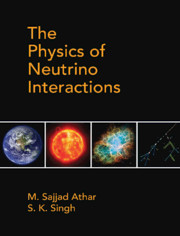Book contents
- Frontmatter
- Dedication
- Contents
- List of Figures
- List of Tables
- Preface
- Acknowledgments
- Chapter 1 Neutrino Properties and Its Interactions
- Chapter 2 Relativistic Particles and Neutrinos
- Chapter 3 Quantization of Free Particle Fields
- Chapter 4 Interacting Fields and Relativistic Perturbation Theory
- Chapter 5 Phenomenological Theory I: Nuclear β-decays and Weak Interaction of Leptons
- Chapter 6 Phenomenological Theory II: Weak Decays of Hadrons
- Chapter 7 Gauge Field Theories and Fundamental Interactions
- Chapter 8 Unified Theory of Electroweak Interactions
- Chapter 9 Neutrino and Electron Scattering from Point Particles
- Chapter 10 Neutrino scattering Cross Sections from Hadrons: Quasielastic Scattering
- Chapter 11 Neutrino Scattering from Hadrons: Inelastic Scattering (I)
- Chapter 12 Neutrino Scattering from Hadrons: Inelastic Scattering (II)
- Chapter 13 Neutrino Scattering from Hadrons: Deep Inelastic Scattering
- Chapter 14 Weak Quasielastic v(⊽)-nucleus Scattering
- Chapter 15 Inelastic Scattering of (Anti)neutrinos from Nuclei
- Chapter 16 Deep Inelastic Scattering of (Anti)neutrinos from Nuclei
- Chapter 17 Neutrino Sources and Detection of Neutrinos
- Chapter 18 Neutrino Mixing and Oscillations
- Chapter 19 Neutrino Astrophysics and the Synthesis of Elements
- Chapter 20 Neutrino Interactions Beyond the Standard Model
- Appendices
- Appendix A Lorentz Transformation and Covariance of the Dirac Equation
- Appendix B Cabibbo Theory
- Appendix C Some Properties of Pauli and Dirac Matrices and Spin Density Matrices
- Appendix D Leptonic and Hadronic Tensors
- Appendix E General Expression for the Total Scattering Cross Section and Decay Rates
- Appendix F Expressions of N(q2), the Coefficients of the Polarization Observables
- References
- Index
Chapter 18 - Neutrino Mixing and Oscillations
Published online by Cambridge University Press: 22 May 2020
- Frontmatter
- Dedication
- Contents
- List of Figures
- List of Tables
- Preface
- Acknowledgments
- Chapter 1 Neutrino Properties and Its Interactions
- Chapter 2 Relativistic Particles and Neutrinos
- Chapter 3 Quantization of Free Particle Fields
- Chapter 4 Interacting Fields and Relativistic Perturbation Theory
- Chapter 5 Phenomenological Theory I: Nuclear β-decays and Weak Interaction of Leptons
- Chapter 6 Phenomenological Theory II: Weak Decays of Hadrons
- Chapter 7 Gauge Field Theories and Fundamental Interactions
- Chapter 8 Unified Theory of Electroweak Interactions
- Chapter 9 Neutrino and Electron Scattering from Point Particles
- Chapter 10 Neutrino scattering Cross Sections from Hadrons: Quasielastic Scattering
- Chapter 11 Neutrino Scattering from Hadrons: Inelastic Scattering (I)
- Chapter 12 Neutrino Scattering from Hadrons: Inelastic Scattering (II)
- Chapter 13 Neutrino Scattering from Hadrons: Deep Inelastic Scattering
- Chapter 14 Weak Quasielastic v(⊽)-nucleus Scattering
- Chapter 15 Inelastic Scattering of (Anti)neutrinos from Nuclei
- Chapter 16 Deep Inelastic Scattering of (Anti)neutrinos from Nuclei
- Chapter 17 Neutrino Sources and Detection of Neutrinos
- Chapter 18 Neutrino Mixing and Oscillations
- Chapter 19 Neutrino Astrophysics and the Synthesis of Elements
- Chapter 20 Neutrino Interactions Beyond the Standard Model
- Appendices
- Appendix A Lorentz Transformation and Covariance of the Dirac Equation
- Appendix B Cabibbo Theory
- Appendix C Some Properties of Pauli and Dirac Matrices and Spin Density Matrices
- Appendix D Leptonic and Hadronic Tensors
- Appendix E General Expression for the Total Scattering Cross Section and Decay Rates
- Appendix F Expressions of N(q2), the Coefficients of the Polarization Observables
- References
- Index
Summary
Introduction
Neutrino oscillation is purely a quantum mechanical phenomenon, in which aneutrino of one flavor, say να develops acomponent of a neutrino of another flavor, sayνβ, whereα, β =e, μ,τ, and α ≠ β.This phenomenon of neutrino oscillation implies that neutrinos have definitemass and their flavor eigenstates are different from their masseigenstates.
The idea of neutrino masses, mixing, and oscillations was first proposed in1957–58 [179] just after the two-component neutrino theory wasconfirmed by the Goldhaber et al. [153] experiment. Pontecorvo [179]conjectured the idea of neutral particle (not necessarily being elementaryparticle) oscillation based on the analogy with kaon regeneration, andargued that : ‘If the two- component neutrino theory should turn outto be incorrect (which at present seems to be rather improbable) and if theconservation law of neutrino charge would not apply, then in principleneutrino ↔ antineutrino transitions could take placein vacu’. At that time only one type of neutrino existed, therefore,for the two-component theory, there were only left-handed neutrinos andright-handed antineutrinos, implying oscillations between. These transitionsare however not possible because of the conservation of total angularmomentum.
Around the same time, Davis [968] conducted an experiment using reactorantineutrino beams and looked for the electron in the reaction
which showed negative results. Contrary to the negative observations, a rumorreached Pontecorvo that Davis has observed the aforementioned event beforethe actual publication of the work. Based on the assumed positive results,in 1958, Pontecorvo, in an another paper [969], concluded that: “Theresult of the Davis experiment was nonzero probability for the process understudy, if confirmed, definitely shows that the (strict) law of neutrinocharge conservation is not valid.” He suggested that the events couldbe due to the transitions. However, this explanation contradicted thetwo-component neutrino theory, where only the left-handed neutrinos or theright-handed antineutrinos participate in the weak interaction. Therefore,the suggestion of νR and similarly, byPontecorvo implies the existence of a class of neutrinos which arenoninteracting; they are called sterile neutrinos.
- Type
- Chapter
- Information
- The Physics of Neutrino Interactions , pp. 708 - 748Publisher: Cambridge University PressPrint publication year: 2020



